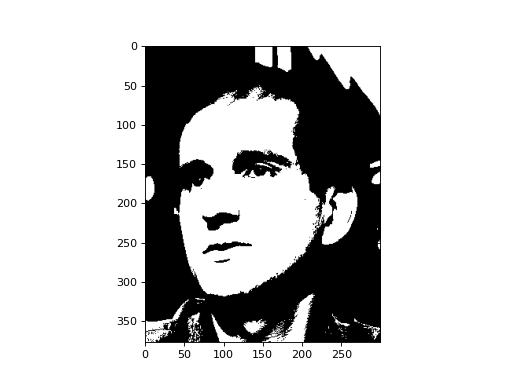Thresholding¶
The example in this section is present in the source under
mahotas/demos/thresholding.py.
We start with an image, a grey-scale image:
import mahotas.demos
photo = mahotas.demos.load('luispedro')
photo = photo.astype(np.uint8)
Before Oct 2013, the mahotas.demos.load function did not exist and you
needed to specify the path explicitly:
luispedro_image = '../../mahotas/demos/data/luispedro.jpg'
photo = mahotas.imread(luispedro_image, as_grey=True)
The reason we convert to np.uint8 is because as_grey returns floating
point images (there are good reasons for this and good reasons against it,
since it’s easier to truncate than to go back, it returns np.uint8).
import mahotas
import mahotas.demos
import numpy as np
from pylab import imshow, gray, show
from os import path
photo = mahotas.demos.load('luispedro', as_grey=True)
photo = photo.astype(np.uint8)
gray()
imshow(photo)
show()
(Source code, png, hires.png, pdf)

Thresholding functions have a trivial interface: they take an image and return a value. One of the most well-known thresholding methods is Otsu’s method:
T_otsu = mahotas.otsu(photo)
print(T_otsu)
imshow(photo > T_otsu)
show()
prints 115.
import mahotas
import mahotas.demos
import numpy as np
from pylab import imshow, gray, show
from os import path
photo = mahotas.demos.load('luispedro', as_grey=True)
photo = photo.astype(np.uint8)
T_otsu = mahotas.otsu(photo)
print(T_otsu)
gray()
imshow(photo > T_otsu)
show()
(Source code, png, hires.png, pdf)

An alternative is the Riddler-Calvard method:
T_rc = mahotas.rc(photo)
print(T_rc)
imshow(photo > T_rc)
show()
In this image, it prints almost the same as Otsu: 115.68. The thresholded
image is exactly the same:
import mahotas
import mahotas.demos
import numpy as np
from pylab import imshow, gray, show
from os import path
photo = mahotas.demos.load('luispedro', as_grey=True)
photo = photo.astype(np.uint8)
T_rc = mahotas.rc(photo)
print(T_rc)
gray()
imshow(photo > T_rc)
show()
(Source code, png, hires.png, pdf)

See also the labeled documentation which can be very helpful in combination with thresholding.
API Documentation¶
The mahotas.thresholding module contains the thresholding functions, but
they are also available in the main mahotas namespace.
Thresholding Module¶
Thresholding functions.
These functions return the numeric threshold. In order to obtain a thresholded image, you can do the following:
T_otsu = mh.otsu(image)
binarized_image = (image > T_otsu)
Functions which have an ignore_zeros parameters will only consider non-zero
pixels when computing the thresholding.
- otsu():
Otsu method
- rc():
Riddler-Calvard’s method
- bernsen:
Bernsen thresholding
- gbernsen:
Generalized Bernsen thresholding
- mahotas.thresholding.bernsen(f, radius, contrast_threshold, gthresh={128})
Bernsen local thresholding
- Parameters:
- fndarray
input image
- radiusinteger
radius of circle (to consider “local”)
- contrast_thresholdinteger
contrast threshold
- gthreshnumeric, optional
global threshold to fall back in low contrast regions
- Returns:
- thresholdedbinary ndarray
See also
gbernsenfunction Generalised Bernsen thresholding
- mahotas.thresholding.gbernsen(f, se, contrast_threshold, gthresh)
Generalised Bernsen local thresholding
- Parameters:
- fndarray
input image
- seboolean ndarray
structuring element to use for “locality”
- contrast_thresholdinteger
contrast threshold
- gthreshnumeric, optional
global threshold to fall back in low contrast regions
- Returns:
- thresholdedbinary ndarray
See also
bernsenfunction Bernsen thresholding with a circular region
- mahotas.thresholding.otsu(img, ignore_zeros=False)
Calculate a threshold according to the Otsu method.
Example:
import mahotas as mh import mahotas.demos im = mahotas.demos.nuclear_image() # im is stored as RGB, let's convert to single 2D format: im = im.max(2) #Now, we compute Otsu: t = mh.otsu(im) # finally, we use the value to form a binary image: bin = (im > t)
See Wikipedia for details on methods: https://en.wikipedia.org/wiki/Otsu’s_method
- Parameters:
- imgan image as a numpy array.
This should be of an unsigned integer type.
- ignore_zerosBoolean
whether to ignore zero-valued pixels (default: False)
- Returns:
- Tinteger
the threshold
- mahotas.thresholding.rc(img, ignore_zeros=False)
Calculate a threshold according to the Riddler-Calvard method.
Example:
import mahotas as mh import mahotas.demos im = mahotas.demos.nuclear_image() # im is stored as RGB, let's convert to single 2D format: im = im.max(2) #Now, we compute a threshold: t = mh.rc(im) # finally, we use the value to form a binary image: bin = (im > t)
- Parameters:
- imgndarray
Image of any type
- ignore_zerosboolean, optional
Whether to ignore zero valued pixels (default: False)
- Returns:
- Tfloat
threshold
- mahotas.thresholding.soft_threshold(f, tval)
Soft threshold function:
^ | / | / | / | / | / - - - - - - - - - - - - - - - - - -> / | / | / | / | / | / |
- Parameters:
- fndarray
- tvalscalar
- Returns:
- thresholdedndarray